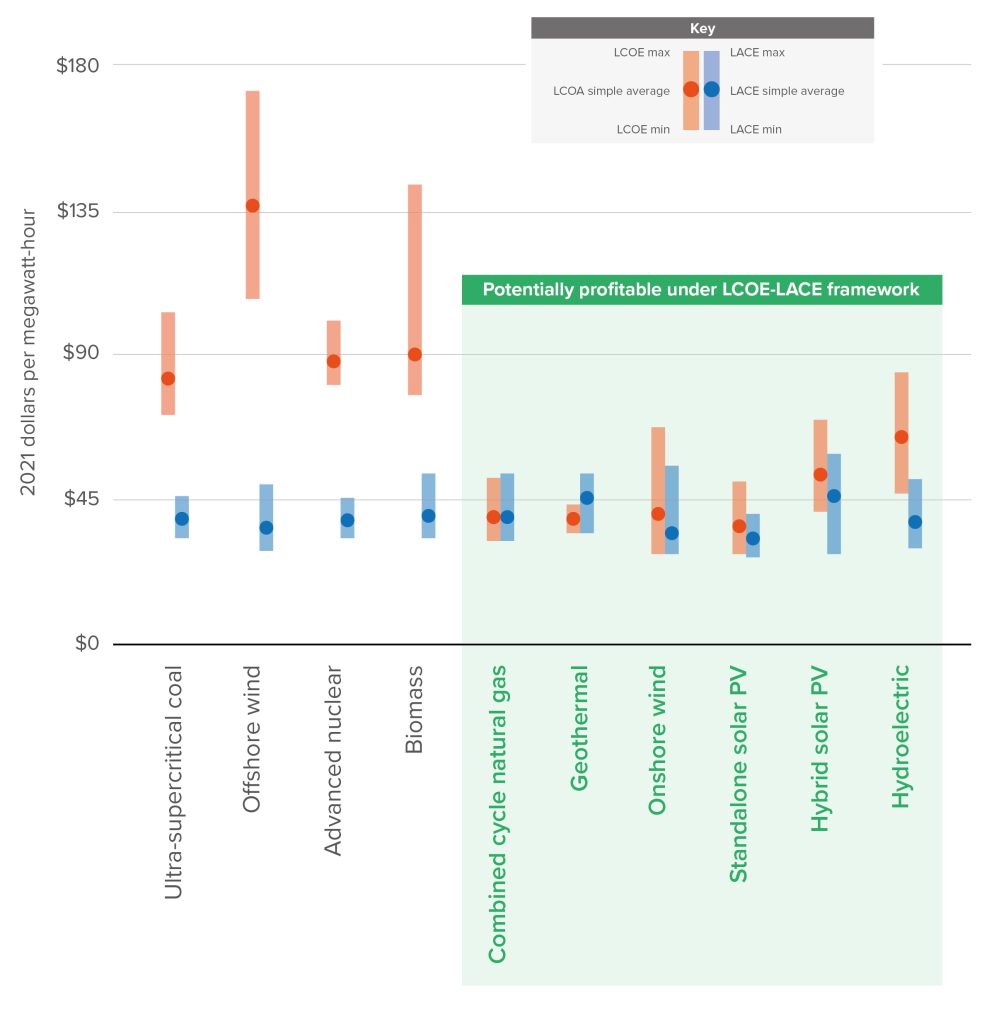Transitioning to the clean energy grid: A deep dive into the levelized cost of electricity
The climate crisis requires the world to transition rapidly from fossil fuel-based to renewable-based electricity generation. Studies of the levelized cost of electricity (LCOE)—the average price at which a power plant must sell each megawatt-hour of electricity to recover its costs—show that renewable electricity generation is well-positioned to meet energy transition goals because it is cost-competitive. LCOE suggests that on-shore wind and solar generation are the cheapest power options in the United States and for two-thirds of the world population. But LCOE does not tell the full story.
Historical mean unsubsidized LCOE values
While this metric is a critical tool for understanding the costs of generating electricity, it does not account for other components of the whole-system cost of electricity, which can add significant costs to the end user. LCOE does not capture the varying costs of capital for projects around the world, the cost of materials, regulatory compliance, legal fees, or the delivery of electricity to the end user. The aging transmission system was not designed to accommodate renewables and must be upgraded and expanded to lower the costs of renewable energy installations.
In addition to the cost of electricity, different electricity generators provide different services—and thus different value—to the grid. The commonly used metric for value is the levelized avoided cost of electricity (LACE). The power grid must be able to supply electricity throughout the year and on days when electricity demand peaks, for which generators provide varying reliability and resilience benefits to the system. Generators also produce electricity at different times, which can affect their total value to the grid. LACE does not, however, include the value of improved health and environmental outcomes from the transition to renewable energy. LACE values vary widely by location due to physical conditions, existing grid assets, and market factors but are relatively similar across technologies on an average basis.
To evaluate the overall suitability of a project, more holistic metrics have been proposed that incorporate both cost and value components of electricity. These metrics are commonly referred to as “profitability metrics” because they calculate the net effect a generator will have on the power system using both cost and value. By combining LCOE and LACE, the cost-benefit ratio of a generating asset becomes clearer. The following figure compares the projected LCOE and LACE for new generators entering service in the United States in 2027. When LACE (in blue) overlaps with or is higher than LCOE (in orange), that project is potentially profitable when considering the limited variables considered by the metrics. The graph suggests that onshore wind, solar photovoltaic, hydroelectric, geothermal, and combined-cycle natural gas generators are all potentially profitable, but that it is highly dependent on location. Still, the additional factors that determine the cost of electricity to the end user are excluded.
Range of LCOE and LACE for energy-generating technologies entering service in 2027 in the United States

Detailed power-system models can incorporate the additional technical and economic variables including transmission and reliability needs to simulate the future of the energy system, allowing for even more granular analysis of potential future scenarios.
These models demonstrate the limitations of using the LCOE alone to predict the future makeup of the energy system and suggest that the transition to renewable energy will be more gradual. However, even these profitability models have limitations. These models do not account for the cost of the damage from emissions that contribute to climate change, which, if incorporated, would vastly scale renewable deployment over fossil fuels. There is also a significant risk that newly built fossil fuel plants will become stranded assets as the world moves toward the clean electricity grid of a net-zero future.
A huge buildout of renewable energy is happening around the world because of the imperatives of addressing the climate crisis and the negative externalities of carbon emissions not included in the models. These factors have led to government mandates, incentives, and increasing public support. In 2022, 74.1 percent of electricity generation capacity additions were renewable. In 2023, 82 percent of planned utility-scale generation capacity additions in the United States are renewable, with solar energy comprising 54 percent of the total. There also is a significant number of renewable facilities waiting to be connected to the grid.
The critical factor enabling this rapid deployment is the competitive, often cheaper cost of generating electricity with renewable energy. Lowering the cost of delivering renewable energy will garner greater public support and accelerate the buildout of additional renewable energy generators. To benefit fully from the lower cost of generating renewables and to achieve a transition to a clean energy system as rapidly as possible, the United States must implement a more efficient planning and permitting process that lowers the cost of the coming system buildout so that renewables are delivered at the cheapest possible cost and at a lower cost than fossil fuel-based energy whenever possible.
The Atlantic Council would like to thank the Fletcher Foundation for supporting our work on this project.
AUTHORS

The Global Energy Center develops and promotes pragmatic and nonpartisan policy solutions designed to advance global energy security, enhance economic opportunity, and accelerate pathways to net-zero emissions.
Image: A view of windmills and power lines, as California's grid operator urged the state's 40 million people to ratchet down the use of electricity in homes and businesses as a wave of extreme heat settled over much of the state, near Tracy, California, U.S., August 17, 2022. REUTERS/Carlos Barria

